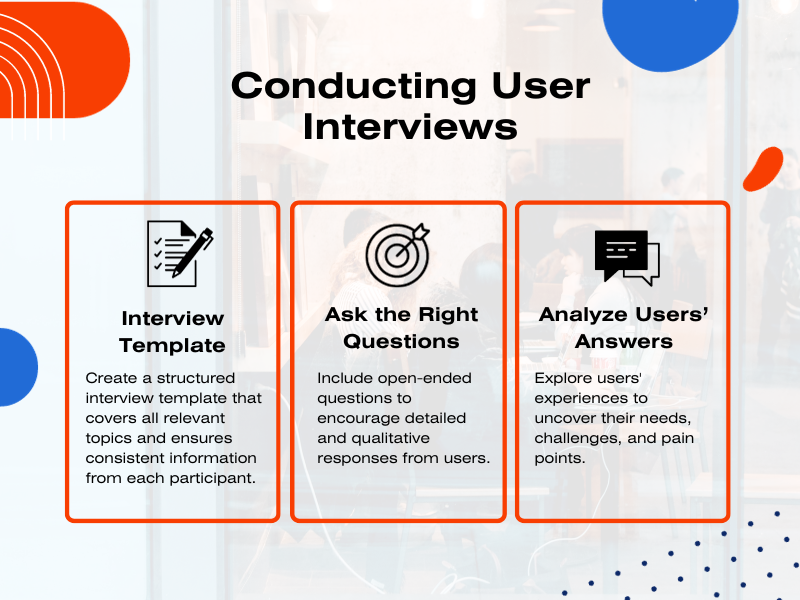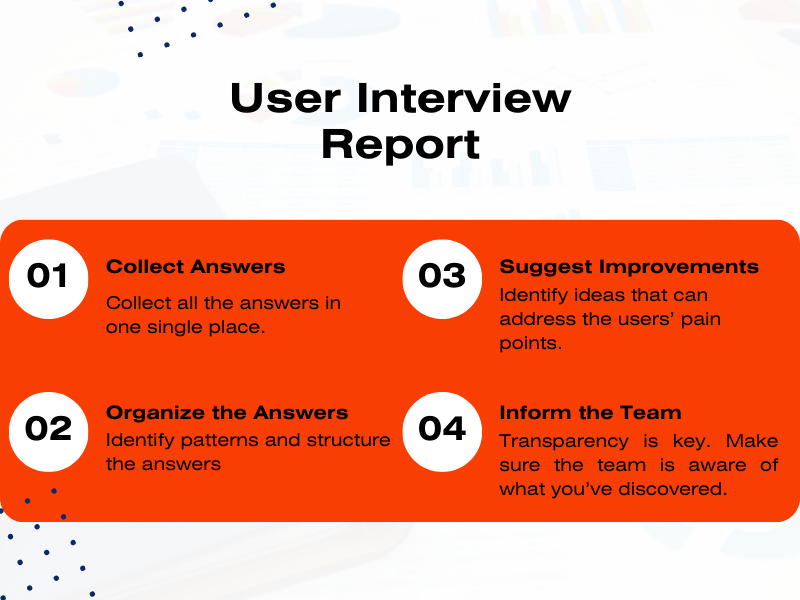User interviews in software development are a powerful tool for product developers and designers. They allow us to gain valuable insights directly from the people who use our products, helping us understand their needs, frustrations, and desires.
However, conducting user interviews can be a challenging task, from finding the right participants to asking the right questions and analyzing the data effectively.
In this blog post, I will clarify the process of user interviews with a music app example and provide you with a step-by-step guide on how to plan, conduct, and extract meaningful insights from these interactions.
Step 1. Define the goals and objectives of the user interview
To achieve a successful user interview, I start by defining the purpose of the interview.
I ask myself, what do I aim to achieve or learn through this interview? Do I want to understand user needs, identify their pain points, validate product ideas that will help me make informed decisions, and refine my product’s user personas? And the list can continue.
As an example, let’s say that I’m developing a music streaming app. My objective could be to gain insights into my users’ music preferences, discover how they currently consume music, and identify opportunities to enhance their music listening experience.
Step 2. Find the right people for the interview
Before proceeding with the interviews, it is crucial for me to identify the users I will be talking with. This will enable me to customize my questions accordingly, as the type of questions for end users is different as compared to those for decision-makers.

Additionally, it’s imperative to ensure that the information is gathered from those who are either using the product or are affected by it. Interviewing individuals who don’t use the product will not provide me with any useful insights.
To find the right people I am looking at a couple of things:
User base segmentation
User base segmentation is about dividing the use base into different groups. Now, I know it sounds like a fancy term, but it’s not rocket science or anything. It’s just a way to make sure everyone gets the best user experience possible. After all, we don’t want anyone feeling left out.
What I do here is identify the most relevant criteria that align with my research goals.
For instance, for my music app, I consider criteria such as usage frequency, subscription type, user behavior patterns, and demographic information like age, location, and gender.
Identify engaged users
Another factor in user interviews is reaching out to engaged users as they provide valuable insights into our products. Engaged users are those who frequently use the product, provide feedback, or spend more time on the platform. To identify and reach out to such users, I analytics tools, prioritize high-value users, and use various communication channels to invite them for interviews.
Review logs and chat transcripts
Reviewing logs or chat transcripts is also a helpful tool. I start by reviewing our customer support logs, which contain records of all the interactions our customers have had with us, such as emails, chats, and trouble tickets.
Then, I look for conversations where customers have expressed concerns, encountered problems, or suggested improvements related to our product or service.
Finally, I analyze the support queries and look for common themes or recurring issues that users have raised. This helps me identify pain points or areas of interest for our users.
Although it might take a bit of time and can sometimes be a tedious process, there’s no denying that the results of reviewing logs and transcripts can be incredibly valuable. While it may not be the most exciting task, it’s important to remember that the information we gather from these interactions can provide us with invaluable insights into our customers’ experiences.
By taking the time to sift through these conversations, we can identify common pain points, recurring issues, and areas for improvement. This information can then be used to inform our product development, customer support strategies, and overall business decisions. So, while it may not be the most thrilling task, the benefits of reviewing logs and transcripts are definitely worth the effort.
Step 3. Create an Interview Guide
Having an interview guide prepared helps me explore users’ experiences, needs, and pain points in a systematic way. Here are some tips:
Create a Structured Interview Guide

Before an interview, I must ensure that I cover all relevant topics and gather consistent information from each participant. Let’s say I’m interviewing the users of my music app, I might structure my questions around topics like user preferences, listening habits, and pain points related to music discovery.
Include Open-Ended Questions
Open-ended questions are a great way to encourage participants to provide detailed and qualitative responses. They allow users to share their thoughts, experiences, and feelings freely. What I do here, instead of asking, “Do you like our music recommendation feature?” I might ask, “Tell me about your experience with our music recommendation feature. How does it influence your music choices?”
Explore Users’ Experiences
One of the key goals of the interview is to understand users’ past experiences with the music app. I might ask questions like, “Can you describe a recent experience when you used our app to discover new music? What did you like or dislike about that experience?”
Uncover Needs and Pain Points
Another goal of the interview is to uncover users’ needs, challenges, and any frustrations they encounter while using the music app. I might ask, “What challenges do you face when creating playlists in our app? Are there any features you wish we had to make playlist management easier?”
Ask About Specific Features
Finally, I might tailor some questions to inquire about particular features or functionalities of the music app that I want to gather feedback on: “Our app recently introduced a lyrics display feature. Have you had a chance to use it? How do you find it helpful or not helpful?”
I hope these tips help you create a great interview guide!
Step 4: Analyze the data
During the interviews, I gather feedback on users’ preferences, pain points, and feature requests related to music streaming on my music app.
Once I’ve coded and analyzed the data, I may identify some recurring themes such as “Personalized Playlist Recommendations,” “Ease of Navigation,” and “Offline Listening.” Through the analysis, I find out that they highly value personalized playlist recommendations, and many of them expressed frustration with the complexity of navigation.
I may also note a strong desire for offline listening options. Based on these insights, I’d recommend prioritizing improvements in playlist recommendation algorithms, simplifying the app’s navigation, and enhancing offline listening features to better align with their needs and expectations.
Step 5. Report Findings

When it comes to reporting findings from user interviews, I follow these simple steps:
First, I collect all the important points and insights from the interviews, including things users liked, didn’t like, or suggested for improvement.
Next, I create a structured document or presentation to present my findings, using bullet points, headings, and visuals to make it easy to understand.
Then, I explain what I discovered, including the main trends, recurring themes, or patterns I found in the user feedback. I use quotes or anecdotes from the interviews to illustrate my points and make my findings more relatable. If I have ideas for improvements or changes based on the feedback, I include them in the report as recommendations. These can guide product development decisions.
Finally, I distribute the report to my team members, including designers, developers, and decision-makers. Everyone involved in the project should know what I learned. By sharing the user’s voice with the entire project team, we can create a better product that meets user needs and expectations.
My report might highlight that users love the feature that suggests new music based on their listening habits, while also revealing that many users find the app’s search function confusing. By sharing these findings, my team can focus on enhancing the recommendation feature and simplifying the search function to improve the user experience
When do I initiate user interviews?
- If I’m looking to refine specific features or introduce significant updates.
- When developing new features. This helps ensure that the new features align with user needs and preferences, and can provide valuable insights that directly influence feature design.
- Lastly, user interviews can be a helpful tool to validate and enhance the existing user personas with fresh insights as it’s important to refine them as the product evolves.
Final Thoughts
To sum up, user interviews are a powerful instrument to develop products that cater to user needs. Though there might be some challenges, such as selecting the right participants and analyzing data, the benefits of conducting user interviews far exceed the difficulties.
In this blog post, we have highlighted the importance of defining objectives, engaging with users, and using customer support interactions. We have also emphasized the value of data analysis and reporting findings.
By following these steps, you will be well-equipped to conduct effective user interviews that will help you make informed product decisions and enhance user experiences. Whether you are an experienced professional or new to the field, mastering user interviews is a gratifying journey. Happy interviewing!

